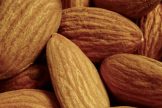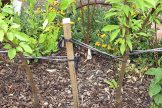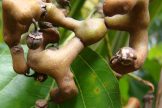
 Important note about plant availability. Important note about plant availability.There are hundreds of factsheets on our website provided for your information. Not all plants will be available at all times throughout the year. To confirm availability please call (03) 8850 3030 and ask for the nursery. |
Espaliered Trees
Espaliering is a form of pruning and training trees as a flat two dimensional specimen. This is usually done against a wall but may also be used to provide a free standing green wall. There are many different shapes that the espalier may take. Traditional espaliers usually have lateral branches trained horizontally at regular spacing. However other shapes may be used including fan, palmette and cordon shapes. Espaliering displays the flowers and fruits very attractively and creates an elegant, compact tree, which is perfectly suited to small gardens.
Flowering Cherries, Crab Apples, Cercis, Laburnum, Crepe Myrtle and Prunus all make stunning espaliers. The fruit trees most suited to this style of training are Apples and Pears. However, other fruit trees such as Plums, Cherries, Peaches, Nectarines, Almonds, Apricots and fruiting vines can also be espaliered in more simple designs. Espaliered trees create a compact, elegant tree whose flowers and fruit are attractively displayed, and spraying and picking fruit is easier and less time-consuming. Fruit is usually produced earlier on espaliered trees. Netting to protect ripening fruit is also easier on a smaller, more compact tree.
Requirements
A constructed support such as trellis or horizontal wires upon a fence is needed to support the tree. Strong posts are required at the ends to hold up the trellis or on which to train wires. Wires must be under tension and need to be thick enough to train the growing stems to. The wires should be spaced 50 to 75 cm apart and space the trees at two to 4 m apart depending on the size of the tree.
Method
Select young trees with evenly spaced branches. Chose the lateral branches to be retained and prune off all other laterals near the trunk. Tie the laterals down to the wires (for a traditional espalier), or onto bamboo canes, which should then be tied into position on the wires (for fan shaped espaliers). Use flexible ties which should be checked regularly for damage to the stems. Prune the tips of the laterals back to the desired length, to a bud. Vertical, inward-facing and weak growth should be removed.
Espaliered trees have the same growing requirements as other fruit and deciduous trees, so remember that
adequate watering in summer and providing the right soil conditions are essential to maintaining a healthy
espaliered tree. Espaliering is a high maintenance technique. Constant pruning and tying in are needed to create the right shape to start with. When the desired shape and size are reached, this must be maintained with regular pruning. Early summer pruning is important to control vigour and prevent shading of the lower limbs.
Winter pruning
Winter pruning is also required, and it is also the time to redefine the shape and size of the espalier.
Pleaching Fruit and Deciduous Trees
Pleaching is a very old technique used with many fruit and ornamental deciduous trees to form a free-standing ‘hedge-on-stilts’. The training is similar to forming an espalier – trees are planted in a line at approximately 2.5m apart, lower branches are removed and lateral branches of adjacent trees are trained to ‘Knit together’ to form a tall hedge. This is very useful to create privacy along a narrow driveway.
Duo and trio fruit trees
This refers to planting two or more trees into the same hole. Commonly done when trees require cross pollinators and/or when space is tight.
Trees will grow on their own root system and with their own growth habit. An advantage is that the stronger growing tree will not dominate the weaker tree which is often a problem in multi grafted trees. A dwarfing effect and earlier fruit may be noticeable due to competition.
Plant the trees around 150mm – 300mm apart and at a very slight outward angle. Judicious pruning to remove some of the branches in the centre triangle (if three trees) or adjacent (if two trees) is ideal when planting. Prune as if one tree, so you have an open structure with tree branches not interfering with each other.
These multiple plantings allow you to fit in cross pollinators, to increase your range of species and lengthen harvest time.
Cordons
A cordon involves training a tree with a single stem. Cordons are planted on a slant and trained up wires at a 45 degree angle, then gradually trained along the top of the wire trellis. This form of training allows many different cultivars to be produced in a small space. It is suitable for many fruit tree cultivars as well as berries.
Ballerina Apples
The Ballerina Apple tree is a compact, columnar tree, which only grows 3.5m tall by 60cm wide. It is perfect for small spaces or growing in pots. This tree requires little or no pruning. Many fruiting apple cultivars are available as well as an ornamental Crab Apple. It produces a large crop of medium to large-sized excellent-flavoured fruit. Fruit matures in mid-late March. Ballerina Apples are partially self-fertile, although another Ballerina Apple, Jonathan, Granny Smith or Dayton planted nearby would be an advantage.
Dwarf Fruit Trees Cultivars of Apples, Nectarines, Peaches and Pomegranates are grafted or bred to produce smaller trees that produce abundant crops of normal-sized fruits. The trees reach approximately 2 x 2 m. These are ideal for container growing or planted in small gardens. Varieties available are Granny Smith, Jonathan, Golden Delicious, Gala and Red Delicious, Nectarine, Peaches (grown primarily for their ornamental value) and Pomegranates.
Standard Forms
Many citrus, roses, hedging and flowering shrubs can be bought or trained as standard forms. The plant is pruned to form a ‘ball on a stick’, displaying flowers, fruit or foliage on a formal plant. Standard Cumquats, Roses and English Box or Lilly Pilly standards can look stunning in small gardens or pots where a formal style or feature is desired.
Trees in Pots
Many fruit trees and deciduous ornamentals can be grown in containers on balconies or in small gardens. This is very useful for people without gardens. A container that holds a large amount of potting mix is necessary. A half wine-barrel with holes drilled is ideal. If the pot is smaller, the tree may need re-potting every 2-3 years and will not produce as much fruit. It is important to use a good quality potting mix and to give the tree a deep, regular soaking, with extra water on hot days. The tree will not grow as large in a pot.
Weeping Fruit & Ornamental Trees
Many deciduous ornamentals, such as Weeping Cherries, Birches, Mulberries or Maples are excellent container grown plants. The same principles apply as above. The plant can be brought out for display when it is at its best or can be under planted with bulbs, ground covers or annuals during the dormant stage.





